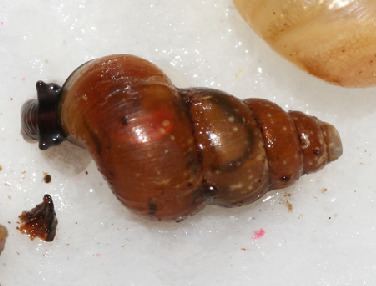Subfamily Pomatiopsinae Rank Genus | ||
 | ||
Similar Fukuia, Pomatiopsidae, Rissooidea, Neotricula aperta, Assiminea | ||
Blanfordia how to pronounce it
Blanfordia is a genus of terrestrial gastropod mollusks in the family Pomatiopsidae. They are land snails which have an operculum.
Contents
The generic name Blanfordia is in honor of English naturalist William Thomas Blanford.
Distribution
The genus Blanfordia is endemic to Japan. Blanfordia species live on Honshu and on Hokkaido.
Blanfodia and Fukuia are the only two genera of Pomatiopsidae that are endemic to Japan. They occur especially in the northern and western part of Japan on the coast of the Sea of Japan. There is a unique climate in the Sea of Japan with high precipitation as snowfall during the winter in the area of distribution of Blanfordia. Such species, unique to the region near the Sea of Japan, are known as "Japan Sea elements".
Description
Some species of Blanfordia have a shell with varix.
Blanfordia has short stubby triangular tentacles. Short tentacles is derived character, while long tentacles is a primitive character (a plesiomorphic trait) within the Littorinimorpha. Eyes are at the base of tentacles. According to Nelson Annandale the snout is narrow and long.
There are lobes on each side of the frontal part of the foot and there is also a lobe with operculum on the foot. There is a groove on the foot dividing the foot into frontal and back part. While moving, it will put the tip of its snout on the ground and then it will drag itself while it is moving each part of the foot separately like a leech.
Gill filaments (ctenidium) are reduced in all species of Blanfordia. There is a verge with a massive gland in some species of Blanfordia. The nervous system of Blanfordia is concentrated.
Reproductive system: the bursa copulatrix is partly surrounded by albumen gland (posterior pallial oviduct). Albumen gland and spermathecal duct have a common opening. Sperm duct and also spermathecal duct emerges from mid-ventral part of the bursa copulatrix.
Paul Bartsch (1936) provided nomenclatural review of the genus Blanfordia with detailed description of its species.
Comparison of apertural views of shells (the scale is 1 mm):
Species
Species within the genus Blanfordia include:
"Fukuia" ooyagii is the most closely related species to Blanfordia according to the molecular phylogeny analysis, but its generic assignment should be determined coupled with the investigation of its soft-part morphology.
The speciation of genus Blanfordia likely started around 6.4 millions years ago in the Late Miocene, while the divergence between Blanfordia and "Fukuia" ooyagii is estimated to be around 17.4 millions years ago in Early Miocene.
Synonyms:
Cladogram
A cladogram showing phylogenic relations of genera within Pomatiopsidae:
Ecology
Blanfordia and Fukuia (that contain terrestrial Fukuia integra) are the only genera of terrestrial gastropods within the family Pomatiopsidae, which otherwise consists of mainly freshwater (but also seasonally amphibious) snails. Species of Blanfordia can be found from the sea coast to the mountains. They live in coastal dunes and littoral forests (Blanfordia simplex), from coastal to inland forests (Blanfordia japonica) and on the forest floor of inland forests (Blanfordia bensoni). Other land snails living in habitats of Blanfordia snails include for example diplommatinids, camaenids and bradybaenids.
The phylogenetic analyses by Kameda & Kato (2011) indicates that Japanese Pomatiopsinae have adapted from freshwater environment to terrestrial life (terrestrialization) at least twice (three Blanfordia species in one clade and Fukuia integra - formerly Blanfordia intergra species in another clade). This change has happened in regions with heavy snowfalls that face the Sea of Japan.
